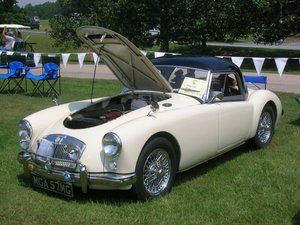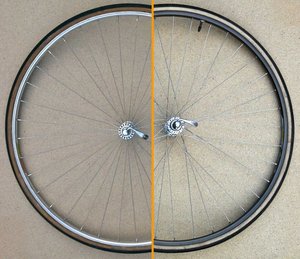Wire wheels
Wire wheels, (wire spoked wheels), today are still used on many motorcycles and most bicycles. Such wheels have a hub connected to a rim by wire spokes. Although these wires are generally stiffer than a typical braided wire cord, they function mechanically the same as tensioned flexible wires, keeping the rim true while supporting applied loads. The process of assembling wire wheels is called wheelbuilding.
"The fundamental fact is that the hub, and thus the vehicle borne by the wheels, in fact hangs on the spokes, which thus have to be tensioned not to break. The spokes can only be put under a pulling strain, otherwise they break."
The above statement illustrates the common perception that the hub of a wire wheel "hangs" from the upper spokes. Although a properly tensioned wire wheel is kept true and round by its spokes that transmit forces between hub and rim by changes in tension, upper spokes in a wheel show no significant change in tension when the wheel is loaded. A vertical load on the hub causes the rim to flatten slightly at the ground, causing spokes in that region to lose some tension by shortening (compressing).
For explanations, computer models, and tests confirming this odd behavior, see this analysis which shows the lower spokes of pre-tensioned bicycle wheels compressing (losing their pre-tension) as they roll under a loaded hub.
The alternative to wire wheels are cast light alloy wheels often called mag wheels.
Before 1960, sports/racing cars often had wire wheels equipped with "knockoff" (central wing nut) hubs, that could be unscrewed by striking a wing of the nut with a mallet (knockoff hammer). In the 60's, cast light-alloy , or "Mag(nesium)" wheels, became common and now predominate. These may have knock-off hubs or power driven hexagonal central nuts, mostly on racing cars. (Racing teams spend large sums to save a few seconds in a pit stop: seconds that can win a race.
Bicycle manufacturers build millions of wheels annually, using the common crossed spoking patterns whose crossings of adjacent spokes are governed by the number of spokes in the wheel. Wheelbuilders, of racing teams and in good bicycle shops, build wheels to other patterns (two-cross, one-cross, no-cross or radial) where the user sees fit. All these patterns have been used for more than 100 years, their value appearing in the publication of Jobst Brandt's seminal book, the Bicycle Wheel, in 1980. Brandt a demanding cyclist who has experience in racing and touring, as well as being a mechanical engineer for Hewlett-Packard. His stress analyses of wheels concluded that crossed patterns had more strength and stability than the other patterns, while irregular patterns were art forms rather having structural merit.
In the 1980's, cast wheels with 5 or 6 rigid spokes began to appear in the Olympic Games and professional racing: these have advantages in specialized applications, such as time trials, but wire-spoked wheels are used for most purposes.
References
- The Bicycle Wheel 3rd Edition, by Jobst Brandt. ISBN 0-9607236-6-8.
See also
External links
- Dayton Wire Wheels
- http://www.astounding.org.uk/ian/wheel/index.html
- http://www.duke.edu/~hpgavin/papers/HPGavin-Wheel-Paper.pdf (PDF format.)


